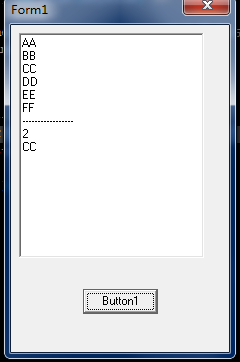------Delphi7
--这里只对正常情况下的枚举举例子,Delphi正常情况下的枚举类型占用一个字节,
C中的枚举不是占一个字节,C可能要用到Delphi的枚举,所以Delphi用编译指令可以把枚举类型的大小改变,也可能占用2字节、4字节
请参考:https://bbs.csdn.net/topics/320097250?list=10622938
type
{$Z+}// 4字节
TMyEnum = (.....);
{$Z-} // 还原1字节
{$A4} // 4字节对其
TMyRecord = record
.....
end;
{$A-} //还原
需要引用:TypInfo单元

-----------------
--Unit开始--
unit Unit1;
interface
uses
Windows, Messages, SysUtils, Variants, Classes, Graphics, Controls, Forms,
Dialogs, StdCtrls, TypInfo;
type
TForm1 = class(TForm)
Memo1: TMemo;
Button1: TButton;
procedure Button1Click(Sender: TObject);
private
{ Private declarations }
public
{ Public declarations }
end;
EMyEnum=(AA,BB,CC,DD,EE,FF);//声明枚举
var
Form1: TForm1;
implementation
{$R *.dfm}
procedure TForm1.Button1Click(Sender: TObject);
var
vEnumStr:string;
venum:EMyEnum;
vP:PTypeInfo;
i:Integer;
begin
Memo1.Clear;
//遍历枚举
vP:=TypeInfo(EMyEnum);
for venum:=Low(EMyEnum) to High(EMyEnum) do
begin
vEnumStr:=GetEnumName(vP,Byte(venum));//枚举最多256个元素,因为只占一个字节,为此猜测Byte(venum)可以得到下标
Memo1.Lines.Add(vEnumStr);
end;
//测试别的
Memo1.Lines.Add('-----------------');
i:=GetEnumValue(vp,'CC');
Memo1.Lines.Add(IntToStr(i));
if EMyEnum(i)=CC then
Memo1.Lines.Add('CC');
end;
end.
--Unit结束
-----Form开始------
object Form1: TForm1
Left = 498
Top = 418
BorderStyle = bsDialog
Caption = 'Form1'
ClientHeight = 327
ClientWidth = 218
Color = clBtnFace
Font.Charset = DEFAULT_CHARSET
Font.Color = clWindowText
Font.Height = -11
Font.Name = 'MS Sans Serif'
Font.Style = []
OldCreateOrder = False
PixelsPerInch = 96
TextHeight = 13
object Memo1: TMemo
Left = 8
Top = 8
Width = 185
Height = 225
ImeName = '中文(简体) - 搜狗拼音输入法'
TabOrder = 0
end
object Button1: TButton
Left = 72
Top = 264
Width = 75
Height = 25
Caption = 'Button1'
TabOrder = 1
OnClick = Button1Click
end
end
-----Form结束-----
---------------------------------------------------其他资料---------------------------------------------
来源:Delphi整理五(枚举、子界、集合) http://www.delphitop.com/html/jichu/3345.html
枚举、子界与集合
枚举
type
<类型名称>=(<标识符1>,<标识符2>...<标识符n>);
1
2
1)类型名称:自定义枚举类型名称
2)标识符:常量元素,个数有限
3)一个枚举类型中,枚举常量不允许重复出现,也不允许同一枚举出现在不同类型中
例如,自动以7个常量的枚举类型
Type
Weekday=(Sun,Mon,Tue,Wed,Thu,Fri,Sat)
1
2
枚举规则:先定义类型在定义变量
var w1,w2,w3:weekday;
a,b,c:integer;
1
2
枚举运算:
1)用pred函数求枚举值的前导。pred(mon)的值为sun,sun没有前导
2)用succ函数求枚举值的后继。succ(sun)的值为mon,sat没有后继
3)用ord函数求枚举值的序号。ord(sun)为0
4)用low函数得第一个枚举值。low(weekday)的值为sun.low(w1)和low(w2)也为sun
5)用high函数求最后一个枚举值
6)使用关系运算符比较枚举值的大小。sun>mon的值为false;tue>=sun的值为true。
子界类型
type
<类型名称>=<常量1>...<常量2>;
1
2
1)<类型名称>是子界类型的名称。
2)<常量1>是子界的下界,<常量2>是子界类型的上界,之间为相同的有序类型(同为整型或同为字符型)
3)子界的上界大于或者等于下界
例,
type
month=1..12;
weekday=(sun,mon,tue,wed,thu,fri,sat);
workday=mon..fri;
1
2
3
4
子界类型变量的定义
规则:先定义类型,再定义变量
type
month=1..12;
weekday=(sun,mon,tue,wed,thu,fri,sat);
workday=mon..fri;
var
m1,m2:month;
w1,w2:workday;
1
2
3
4
5
6
7
不建议:m1,m2:1..12;
集合整型
1)集合中的元素是相异的。(不重复)
2)集合中的元素是没有顺序的
3)集合中的元素不能超过256个
集合的定义:
type
<类型名称>=set of<基类型>;
1
2
1)<类型名称>是用户所定义的集合类型的名称
2)<基类型>是集合中元素的类型,可以是字符、布尔、枚举、子界等类型,不能是整型、实型
例,
type
days=set of 28..31;
ch=set of 'A'..'Z';
weekday=(sun,tue,wed,thu,fri,sat);
workday=set of weekday;
1
2
3
4
5
集合类型变量的定义:
先定义集合类型
type
days=set of 28..31;
ch=set of 'A'..'Z';
weekday=(sun,...,sat);
workday=set of weekday;
1
2
3
4
5
再定义集合类型的变量
var
ch1,ch2:ch;
wo1,wo2:workday;
d1,d2:days;
1
2
3
4
集合类型的取值和运算
集合的取值称之为集合的值。
type
weekday=(sun,mon,tue,wed,thu,fir,sat);
workday=set of weekday;
var
wo1,wo2:workday;
wo1的值可以为[]、[sun]、[sun,mon]...
1
2
3
4
5
6
1)一个集合的基类型有n个值,那么集合变量的取值有2的n次方个。
2)[]是空集合
3)集合元素连续出现,可以写成子界形式。1..12等价于1到12
集合的运算
交、差、并运算和集合间的关系运算
前者得到的集合类型或者是boolean类型
1)集合的并。两个集合的所有元素组成(去掉重复的)
2)集合的交运算。两集合公有的
3)集合的差。一个集合去掉公有的 []()
4)相等运算返回false or true
5)不相等运算(<>)返回false or true
6)包含运算。后者有的前者全有都有(>=)false or true
7)被包含运算。前者有的后者都有(<=)false or true
8)元素与集合的运算,判断元素是否在集合中。2 in[1,2,3]的值为true
------------
发现这个也有遍历枚举:Delphi7遍历枚举,子界 - kiny - 博客园 https://www.cnblogs.com/kiny/articles/2676628.html
-------------------------------------------------------
-----------------------结束---------------------------------
-----新篇------------
-------------------------------------------------------------------------------------
--------------------字符串转枚举(利用泛型)----------------
需要Uses: TypInfo, SysConst
1 TEnumConvert<T> = class 2 public 3 class function StrToEnumType(const S: string): T; overload; 4 class function StrToEnumType(const S: string; Default: T): T; overload; 5 class function EnumToString(Value: T): string; 6 end; 7 8 9 10 11 12 implementation 13 14 { TEnumConvert<T> } 15 16 class function TEnumConvert<T>.EnumToString(Value: T): string; 17 var 18 v: Integer; 19 begin 20 case PTypeInfo(TypeInfo(T))^.Kind of 21 tkEnumeration: 22 case TypInfo.GetTypeData(TypeInfo(T))^.OrdType of 23 otUByte, otSByte: v := PByte(@Value)^; 24 otUWord, otSWord: v := PWord(@Value)^; 25 otULong, otSLong: v := PInteger(@Value)^; 26 end; 27 else 28 raise EInvalidCast.CreateRes(@SInvalidCast); 29 end; 30 Result := TypInfo.GetEnumName(TypeInfo(T), v); 31 //Result := TValue.From<T>(Value).ToString;//Rtti 32 end; 33 34 class function TEnumConvert<T>.StrToEnumType(const S: string): T; 35 begin 36 case PTypeInfo(TypeInfo(T))^.Kind of 37 tkEnumeration: 38 case TypInfo.GetTypeData(TypeInfo(T))^.OrdType of 39 otUByte, otSByte: PByte(@Result)^ := GetEnumValue(TypeInfo(T), S); 40 otUWord, otSWord: PWord(@Result)^ := GetEnumValue(TypeInfo(T), S); 41 otULong, otSLong: PInteger(@Result)^ := GetEnumValue(TypeInfo(T), S); 42 end; 43 else 44 raise EInvalidCast.CreateRes(@SInvalidCast); 45 end; 46 end; 47 48 class function TEnumConvert<T>.StrToEnumType(const S: string; Default: T): T; 49 begin 50 if S <> '' then 51 Result := StrToEnumType(S) 52 else 53 Result := Default; 54 end;




